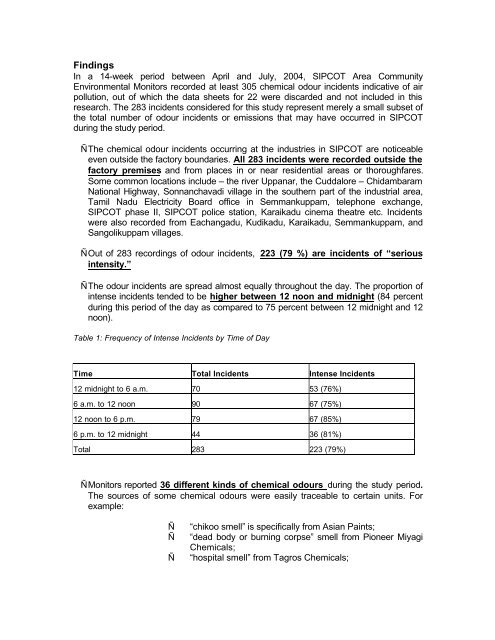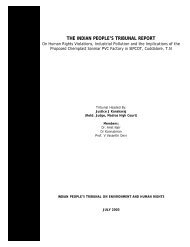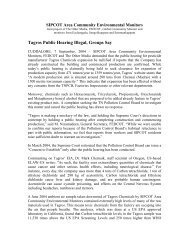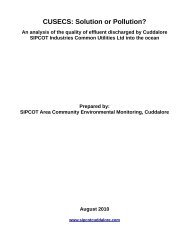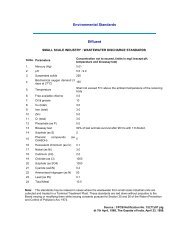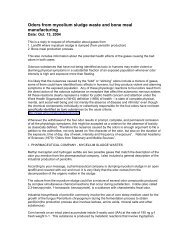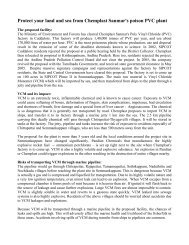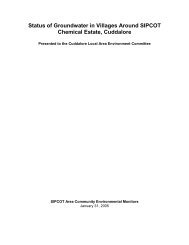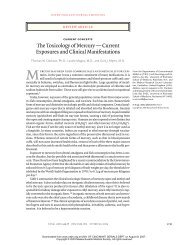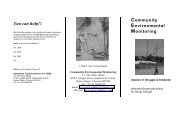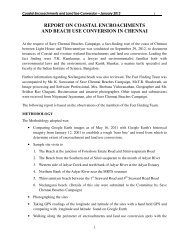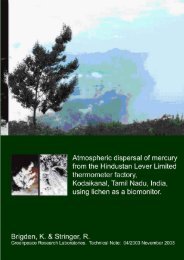Chemical Odour Incidents in SIPCOT Industrial Area, Cuddalore
Chemical Odour Incidents in SIPCOT Industrial Area, Cuddalore
Chemical Odour Incidents in SIPCOT Industrial Area, Cuddalore
Create successful ePaper yourself
Turn your PDF publications into a flip-book with our unique Google optimized e-Paper software.
F<strong>in</strong>d<strong>in</strong>gs<br />
In a 14-week period between April and July, 2004, <strong>SIPCOT</strong> <strong>Area</strong> Community<br />
Environmental Monitors recorded at least 305 chemical odour <strong>in</strong>cidents <strong>in</strong>dicative of air<br />
pollution, out of which the data sheets for 22 were discarded and not <strong>in</strong>cluded <strong>in</strong> this<br />
research. The 283 <strong>in</strong>cidents considered for this study represent merely a small subset of<br />
the total number of odour <strong>in</strong>cidents or emissions that may have occurred <strong>in</strong> <strong>SIPCOT</strong><br />
dur<strong>in</strong>g the study period.<br />
Ñ The chemical odour <strong>in</strong>cidents occurr<strong>in</strong>g at the <strong>in</strong>dustries <strong>in</strong> <strong>SIPCOT</strong> are noticeable<br />
even outside the factory boundaries. All 283 <strong>in</strong>cidents were recorded outside the<br />
factory premises and from places <strong>in</strong> or near residential areas or thoroughfares.<br />
Some common locations <strong>in</strong>clude – the river Uppanar, the <strong>Cuddalore</strong> – Chidambaram<br />
National Highway, Sonnanchavadi village <strong>in</strong> the southern part of the <strong>in</strong>dustrial area,<br />
Tamil Nadu Electricity Board office <strong>in</strong> Semmankuppam, telephone exchange,<br />
<strong>SIPCOT</strong> phase II, <strong>SIPCOT</strong> police station, Karaikadu c<strong>in</strong>ema theatre etc. <strong>Incidents</strong><br />
were also recorded from Eachangadu, Kudikadu, Karaikadu, Semmankuppam, and<br />
Sangolikuppam villages.<br />
Ñ Out of 283 record<strong>in</strong>gs of odour <strong>in</strong>cidents, 223 (79 %) are <strong>in</strong>cidents of “serious<br />
<strong>in</strong>tensity.”<br />
Ñ The odour <strong>in</strong>cidents are spread almost equally throughout the day. The proportion of<br />
<strong>in</strong>tense <strong>in</strong>cidents tended to be higher between 12 noon and midnight (84 percent<br />
dur<strong>in</strong>g this period of the day as compared to 75 percent between 12 midnight and 12<br />
noon).<br />
Table 1: Frequency of Intense <strong>Incidents</strong> by Time of Day<br />
Time Total <strong>Incidents</strong> Intense <strong>Incidents</strong><br />
12 midnight to 6 a.m. 70 53 (76%)<br />
6 a.m. to 12 noon 90 67 (75%)<br />
12 noon to 6 p.m. 79 67 (85%)<br />
6 p.m. to 12 midnight 44 36 (81%)<br />
Total 283 223 (79%)<br />
Ñ Monitors reported 36 different k<strong>in</strong>ds of chemical odours dur<strong>in</strong>g the study period.<br />
The sources of some chemical odours were easily traceable to certa<strong>in</strong> units. For<br />
example:<br />
Ñ<br />
Ñ<br />
Ñ<br />
“chikoo smell” is specifically from Asian Pa<strong>in</strong>ts;<br />
“dead body or burn<strong>in</strong>g corpse” smell from Pioneer Miyagi<br />
<strong>Chemical</strong>s;<br />
“hospital smell” from Tagros <strong>Chemical</strong>s;


